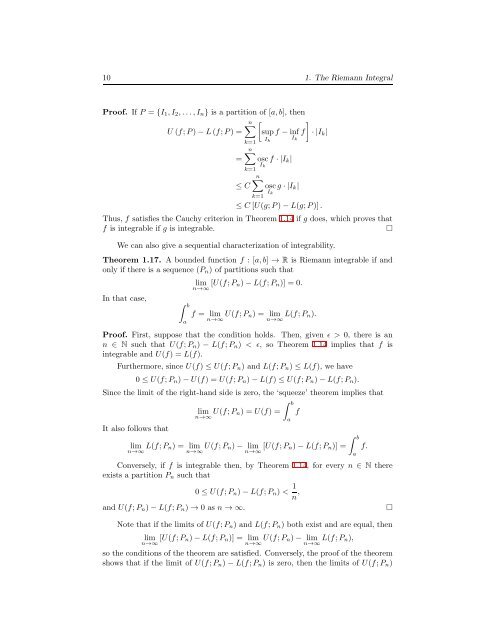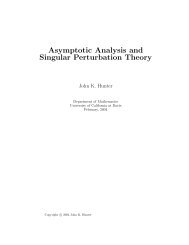The Riemann Integral
The Riemann Integral
The Riemann Integral
You also want an ePaper? Increase the reach of your titles
YUMPU automatically turns print PDFs into web optimized ePapers that Google loves.
10 1. <strong>The</strong> <strong>Riemann</strong> <strong>Integral</strong><br />
Proof. If P = {I 1 ,I 2 ,...,I n } is a partition of [a,b], then<br />
n∑<br />
[ ]<br />
U (f;P)−L(f;P) = supf −inff<br />
·|I k |<br />
I k<br />
I k<br />
=<br />
≤ C<br />
k=1<br />
n∑<br />
k=1<br />
osc<br />
I k<br />
f ·|I k |<br />
n∑<br />
k=1<br />
osc<br />
I k<br />
g ·|I k |<br />
≤ C[U(g;P)−L(g;P)].<br />
Thus, f satisfies the Cauchy criterion in <strong>The</strong>orem 1.14 if g does, which proves that<br />
f is integrable if g is integrable.<br />
□<br />
We can also give a sequential characterization of integrability.<br />
<strong>The</strong>orem 1.17. A bounded function f : [a,b] → R is <strong>Riemann</strong> integrable if and<br />
only if there is a sequence (P n ) of partitions such that<br />
In that case,<br />
∫ b<br />
a<br />
lim [U(f;P n)−L(f;P n )] = 0.<br />
n→∞<br />
f = lim<br />
n→∞ U(f;P n) = lim<br />
n→∞ L(f;P n).<br />
Proof. First, suppose that the condition holds. <strong>The</strong>n, given ǫ > 0, there is an<br />
n ∈ N such that U(f;P n ) − L(f;P n ) < ǫ, so <strong>The</strong>orem 1.14 implies that f is<br />
integrable and U(f) = L(f).<br />
Furthermore, since U(f) ≤ U(f;P n ) and L(f;P n ) ≤ L(f), we have<br />
0 ≤ U(f;P n )−U(f) = U(f;P n )−L(f) ≤ U(f;P n )−L(f;P n ).<br />
Since the limit of the right-hand side is zero, the ‘squeeze’ theorem implies that<br />
It also follows that<br />
lim U(f;P n) = U(f) =<br />
n→∞<br />
lim L(f;P n) = lim U(f;P n)− lim [U(f;P n)−L(f;P n )] =<br />
n→∞ n→∞ n→∞<br />
Conversely, if f is integrable then, by <strong>The</strong>orem 1.14, for every n ∈ N there<br />
exists a partition P n such that<br />
∫ b<br />
0 ≤ U(f;P n )−L(f;P n ) < 1 n ,<br />
a<br />
f<br />
∫ b<br />
a<br />
f.<br />
and U(f;P n )−L(f;P n ) → 0 as n → ∞.<br />
□<br />
Note that if the limits of U(f;P n ) and L(f;P n ) both exist and are equal, then<br />
lim [U(f;P n)−L(f;P n )] = lim U(f;P n)− lim L(f;P n),<br />
n→∞ n→∞ n→∞<br />
so the conditions of the theorem are satisfied. Conversely, the proof of the theorem<br />
shows that if the limit of U(f;P n ) −L(f;P n ) is zero, then the limits of U(f;P n )
















